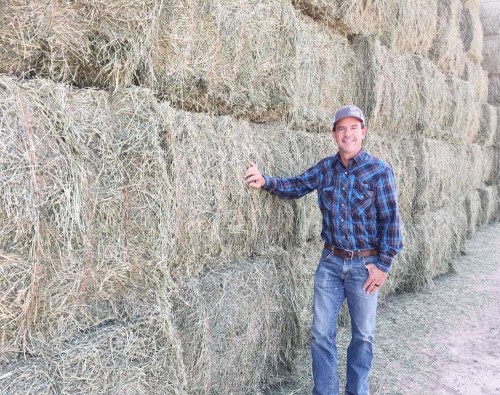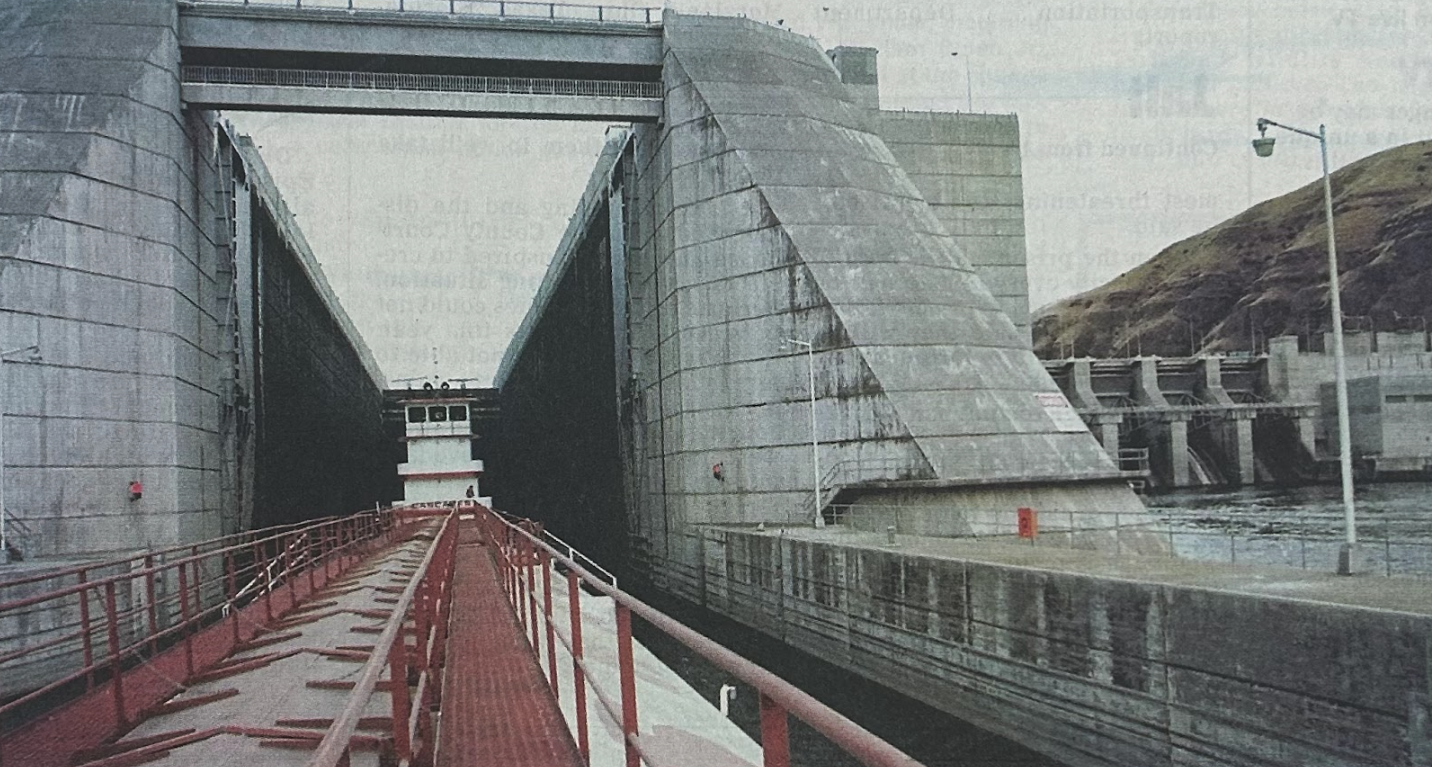Drought scorches NW hay crop, squeezes beef cattle, dairy producers
Published 2:46 pm Friday, October 22, 2021

- Pat Purdy, a partner at Purdy Enterprises, beside stacked hay on the family farm and ranch in Picabo, Idaho, on Sept. 8, 2021.
PICABO, Idaho — Now harvesting his third and final cutting of hay, Pat Purdy is grateful his irrigation water got turned back on and the crop is looking good.
“Our second cutting of hay was off significantly, probably 30 to 40%,” said Purdy, who is part owner of his family’s Picabo Livestock Company.
The reason: Purdy’s irrigation water had been cut off for eight days at a critical time for the crop.
“That definitely put a dent in our second cutting,” he said. The crop missed out on the last one or two water cycles it would normally get.
As the region-wide drought and tight water supplies continue to shrink the amount of hay grown this year, it’s hurting the farmers who grow it — and the ranchers and dairy operators who depend on the crop to feed their livestock.
In Purdy’s case, the state Department of Water Resources curtailed groundwater rights in the lower Wood River Valley until junior irrigators negotiated an agreement with senior surface-water users to get some of their water turned back on.
His first cutting of hay was off as well, but it wasn’t as severe, Purdy said.
“The two biggest issues were early and pervasive heat and water shut off the first of July,” he said.
Temperatures in the mid-90s in June followed above-average heat in May. That stresses alfalfa, causing it to bloom early — which means it has to be cut, he said.
The Purdy operation grows about 2,000 acres of hay — alfalfa to sell for dairy hay and grass hay to feed his family’s 750 pairs of beef cattle. Yields on the grass hay are down a little this year, so he kept back some of the dairy hay for his cattle.
“I think we’re going to have enough to get us through the winter,” he said.
But the hay supply is tight, and prices are high. Dairy-quality hay in his market is selling for about $240 a ton. Last year it peaked at $180 a ton.
“So it’s up significantly. A $60 swing is a pretty substantial move in pricing,” he said.
The drought is having a big effect on hay supply and markets across the region, said Mark T. Anderson, president and CEO of Anderson Hay & Grain Co., a major exporter of Pacific Northwest hay and straw.
“It’s been quite a few years since hay stocks were really cleaned up … eight to 10 years,” he said.
In the West, hay stocks have tightened at the same time as the drought, and demand is especially high, he said.
While exports influence the hay market, domestic demand still is the biggest driver, he said.
“When hay stocks are tight and a drought is driving up domestic demand, you see what we’re seeing now — really high prices,” he said.
Depending on quality, alfalfa hay is selling for $150 to $230 a ton, up $50 a ton from average, he said.
Based on acreage, yields and demand, “we’ll definitely be putting less inventory together this year for export,” he said.
The company will manage to secure about as much alfalfa as planned, but Timothy hay and grass straw supplies will definitely be down, he said.
Deep drought
The U.S. Drought Monitor map for the West is emblazoned with deep hues of orange and red. As of Sept. 28, 93% of the region was in some level of drought — and 81% was in severe, extreme or exceptional drought.
“The drought is widespread all across the West,” said Shannon Neibergs, a Washington State University agricultural economist and director of WSU’s Center for Risk Management in Spokane.
The curious thing is published reports on hay production don’t seem to portray the drought’s impacts as dire as he’s hearing from farmers. Dryland alfalfa producers across the region are saying they’ll be lucky to get a second cutting, he said.
Nationwide, alfalfa hay production is expected to be down 12% this year on 16.1 million acres, a decline of 107,000 acres compared to 2020. Production of other hay is expected to be down 4% on 35.4 million acres, a decline of 594,000 acres.
In the Pacific Northwest — Washington, Oregon and Idaho — alfalfa production is expected to be down 10% on 1.8 million acres, an increase of 30,000 acres. Production of other hay is expected to be down 18% in the region on 1.17 million acres, the same as last year.
In addition to more moderate production declines than he’d expected, published hay prices aren’t as high as farmers are reporting. Some growers are reporting prices $100 a ton higher than the published reports — with people scrambling to find it, Neibergs said.
Tighter hay supplies are reflected in alfalfa prices, with demand also being driven by strong exports to such countries as China, he said.
“That’s just more competition for the sources we have,” he said.
Another factor is the loss of grazing resources due to wildfires that have continued to burn grazing land around the region, he said.
“It’s harder to find hay because people have a high demand from a wider area of people willing to transport it farther,” he said.
There are lots of stories, but not much data, on hay being transported from the Palouse region — southeastern Washington and north-central Idaho — to Montana, which is unusual, he said.
High demand
The Idaho Hay and Forage Association is getting calls almost every day from dairies and beef cattle operations looking for hay — and from hay farmers saying they’re out of water, said Will Ricks, president of the association and an eastern Idaho grower.
He recently drove through a portion of central Idaho where irrigation pivots that would normally be running were shut off.
“It’s just really, really dry up there. They rely on a lot of snowpack, and there really wasn’t much … this year,” he said.
“We’re definitely not going to have the tonnage we’ve had in other years, and no carryover,” he said.
Ranchers needing hay to feed cattle better be tying it up right now, he said.
“Come February, there’s just not going to be any hay around,” he said.
He said he just saw a report that some parts of the West have had the driest growing season since record-keeping began 126 years ago.
“That’s having an effect on hay production for sure,” he said.
There are reports of farmers all over the state being out of water, and crops are just burning up, particularly in central Idaho. Hay growers there aren’t getting a second cutting, he said.
But in some other areas farmers haven’t had to reduce water use. So far, it hasn’t been much of an issue in eastern Idaho, where growers typically get three cuttings, he said.
Most hay prices have been higher than last year, he said, estimating jumps of $20 to $30 a ton.
Livestock woes
Those higher prices and tight hay supplies in the West are especially tough on livestock producers.
The value of livestock production in the nine western states was $10.5 billion for cattle and calves and $13 billion for milk in the 2017 Census of Agriculture.
The drought is hitting just about every region west of the Mississippi River, said Larry Schnell, managing partner of Stockman’s Livestock Exchange in Dickinson, N.D., and president of the Livestock Marketing Association.
“It’s a pretty sad story in all of the West,” he said.
The situation is dire with very little feed, especially in the northern tier states of the Dakotas, Montana, Washington and Oregon, as well as Nebraska, Wyoming and Utah. Even Arizona and Nevada conditions are worse than normal, he said.
California is experiencing its worst drought in memory, he said. A lot of the state is short of water, and ranchers are having to haul water or put in pipelines, he said.
“People are having to sit down at their kitchen table and figure out how much feed they have and how many cows need to be sold,” he said.
“There are many, many cows being sold, and will be to the first of the year,” he said.
Almost any livestock auction in the West is selling almost three times what it would normally sell this time of year, he said, adding that ranchers are selling calves early and selling cows because they can’t afford to feed them through the winter.
“They want to hang onto as many cows as possible,” he said.
But North Dakota’s cow herd is going to be down 20% to 30%. In some other states, it’s going to be down 50%, he said.
“There are very few states west of the Mississippi that aren’t in very dire trouble,” he said.
Ranchers typically put up hay and other feed for winter, but the drought means there’s little to be had at any price. In North Dakota, growers are getting 1 bale of hay an acre, or less.
Basically, there’s no hay in North Dakota and ranchers are having to reach into Minnesota and Iowa to find any, he said.
Dairy farmers are in the same squeeze. Hay prices are up and supplies are down, said James Carr, West Coast dairy director for StoneX, a commodities trading consultant.
“Not only is it hard to find but when you do find it, it’s expensive,” he said.
Supreme dairy hay is going for $240 to $250 a ton, $70 to $80 more than a year ago. Good feeder hay is selling for $225 to $240, compared to $140 to $150 last year, he said.
Other feed costs, including corn and soybean meal, are also up this year, but there are signs those prices could moderate going into harvest, he said.
Back at the ranch
At Picabo Livestock — about 70 miles northeast of Twin Falls — Purdy is just glad his irrigation water got turned back on.
Otherwise, his third cutting of hay would have suffered a fate similar to that of the meager second cutting, forcing him to hold back more of the cash crop to feed his cattle through the winter.
“Surprisingly, the third cutting is getting pretty good yields. It looks actually a little bit up,” he said.
He estimated his total volume for the entire season will be down about 15% to 20% from normal.
But, he said, it could have been worse.
He doesn’t have as much hay to sell, but his hay storage is full and he’ll have enough to get the beef cattle herd through the winter.
But there remain a lot of nervous producers out there. There’s a lot higher hay demand than can be met, hay prices are high and people have had to sell cows, he said.
“If we have a hard winter, which is what we need (to make up for the drought), it’s going to be hard on some cattle producers,” he said.









